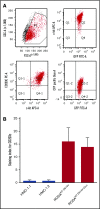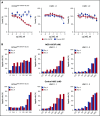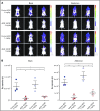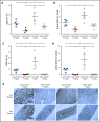In vitro and in vivo efficacy of an anti-CD203c conjugated antibody (AGS-16C3F) in mouse models of advanced systemic mastocytosis
- PMID: 30804017
- PMCID: PMC6391676
- DOI: 10.1182/bloodadvances.2018026179
In vitro and in vivo efficacy of an anti-CD203c conjugated antibody (AGS-16C3F) in mouse models of advanced systemic mastocytosis
Abstract
Antibody-drug conjugates (ADCs) are a new class of therapeutics that use antibodies to deliver potent cytotoxic drugs selectively to cancer cells. CD203c, an ecto-nucleotide pyrophosphatase-phosphodiesterase 3, is overexpressed on neoplastic mast cells (MCs) in systemic mastocytosis (SM), thus representing a promising target for antibody-mediated therapy. In this study, we have found that human neoplastic MC lines (ROSAKIT D816V and ROSAKIT D816V-Gluc), which express high levels of CD203c, are highly and specifically sensitive to the antiproliferative effects of an ADC against CD203c (AGS-16C3F). In these cell lines, AGS-16C3F induced cell apoptosis at very low concentrations. To characterize the effects of AGS-16C3F on leukemia progression in vivo, ROSAKIT D816V-Gluc NOD-SCID γ mouse models of advanced SM (AdvSM) were treated with AGS-16C3F or an ADC control for 2 weeks. Whereas AGS-16C3F had no apparent toxicity in xenotransplanted mice, in vivo neoplastic MC burden significantly decreased in both hematopoietic and nonhematopoietic organs. Furthermore, animals treated with AGS-16C3F had prolonged survival compared with the animals treated with control ADC, and AGS-16C3F efficiently prevented disease relapse. In conclusion, these preclinical studies identified CD203c as a novel therapeutic target on neoplastic MCs, and AGS-16C3F as a promising ADC for the treatment of patients with AdvSM.
© 2019 by The American Society of Hematology.
Conflict of interest statement
Conflict-of-interest disclosure: At the time of the research, H.K.-M. and F.D. were both employees of Agensys, Inc. The remaining authors declare no competing financial interests.
Figures







Similar articles
-
A new humanized in vivo model of KIT D816V+ advanced systemic mastocytosis monitored using a secreted luciferase.Oncotarget. 2016 Dec 13;7(50):82985-83000. doi: 10.18632/oncotarget.12824. Oncotarget. 2016. PMID: 27783996 Free PMC article.
-
Modulation of Macropinocytosis-Mediated Internalization Decreases Ocular Toxicity of Antibody-Drug Conjugates.Cancer Res. 2018 Apr 15;78(8):2115-2126. doi: 10.1158/0008-5472.CAN-17-3202. Epub 2018 Jan 30. Cancer Res. 2018. PMID: 29382707
-
Inhibition of Megakaryocyte Differentiation by Antibody-Drug Conjugates (ADCs) is Mediated by Macropinocytosis: Implications for ADC-induced Thrombocytopenia.Mol Cancer Ther. 2017 Sep;16(9):1877-1886. doi: 10.1158/1535-7163.MCT-16-0710. Epub 2017 Jun 27. Mol Cancer Ther. 2017. PMID: 28655784
-
Preclinical human models and emerging therapeutics for advanced systemic mastocytosis.Haematologica. 2018 Nov;103(11):1760-1771. doi: 10.3324/haematol.2018.195867. Epub 2018 Jul 5. Haematologica. 2018. PMID: 29976735 Free PMC article. Review.
-
Clinical Validation of KIT Inhibition in Advanced Systemic Mastocytosis.Curr Hematol Malig Rep. 2018 Oct;13(5):407-416. doi: 10.1007/s11899-018-0469-3. Curr Hematol Malig Rep. 2018. PMID: 30155614 Review.
Cited by
-
Discovery of potent nucleotide pyrophosphatase/phosphodiesterase3 (NPP3) inhibitors with ancillary carbonic anhydrase inhibition for cancer (immuno)therapy.RSC Med Chem. 2021 Jun 16;12(7):1187-1206. doi: 10.1039/d1md00117e. eCollection 2021 Jul 21. RSC Med Chem. 2021. PMID: 34355184 Free PMC article.
-
Marine Anticancer Agents: An Overview with a Particular Focus on Their Chemical Classes.Mar Drugs. 2020 Dec 4;18(12):619. doi: 10.3390/md18120619. Mar Drugs. 2020. PMID: 33291602 Free PMC article. Review.
References
-
- Ustun C, Arock M, Kluin-Nelemans HC, et al. . Advanced systemic mastocytosis: from molecular and genetic progress to clinical practice. Haematologica. 2016;101(10):1133-1143. - PubMed
-
- Valent P, Escribano L, Broesby-Olsen S, et al. ; European Competence Network on Mastocytosis. Proposed diagnostic algorithm for patients with suspected mastocytosis: a proposal of the European Competence Network on Mastocytosis. Allergy. 2014;69(10):1267-1274. - PubMed
-
- Arock M, Akin C, Hermine O, Valent P. Current treatment options in patients with mastocytosis: status in 2015 and future perspectives. Eur J Haematol. 2015;94(6):474-490. - PubMed
-
- Pardanani A. Systemic mastocytosis in adults: 2017 update on diagnosis, risk stratification and management. Am J Hematol. 2016;91(11):1146-1159. - PubMed
Publication types
MeSH terms
Substances
LinkOut - more resources
Full Text Sources
Other Literature Sources
Molecular Biology Databases

